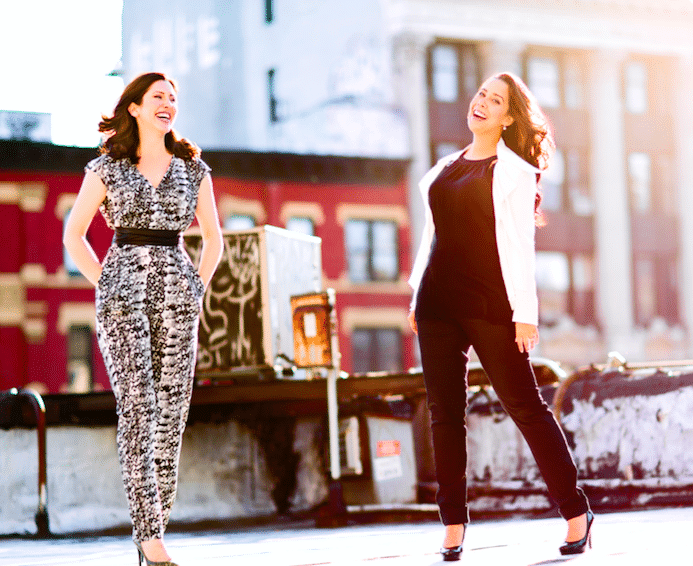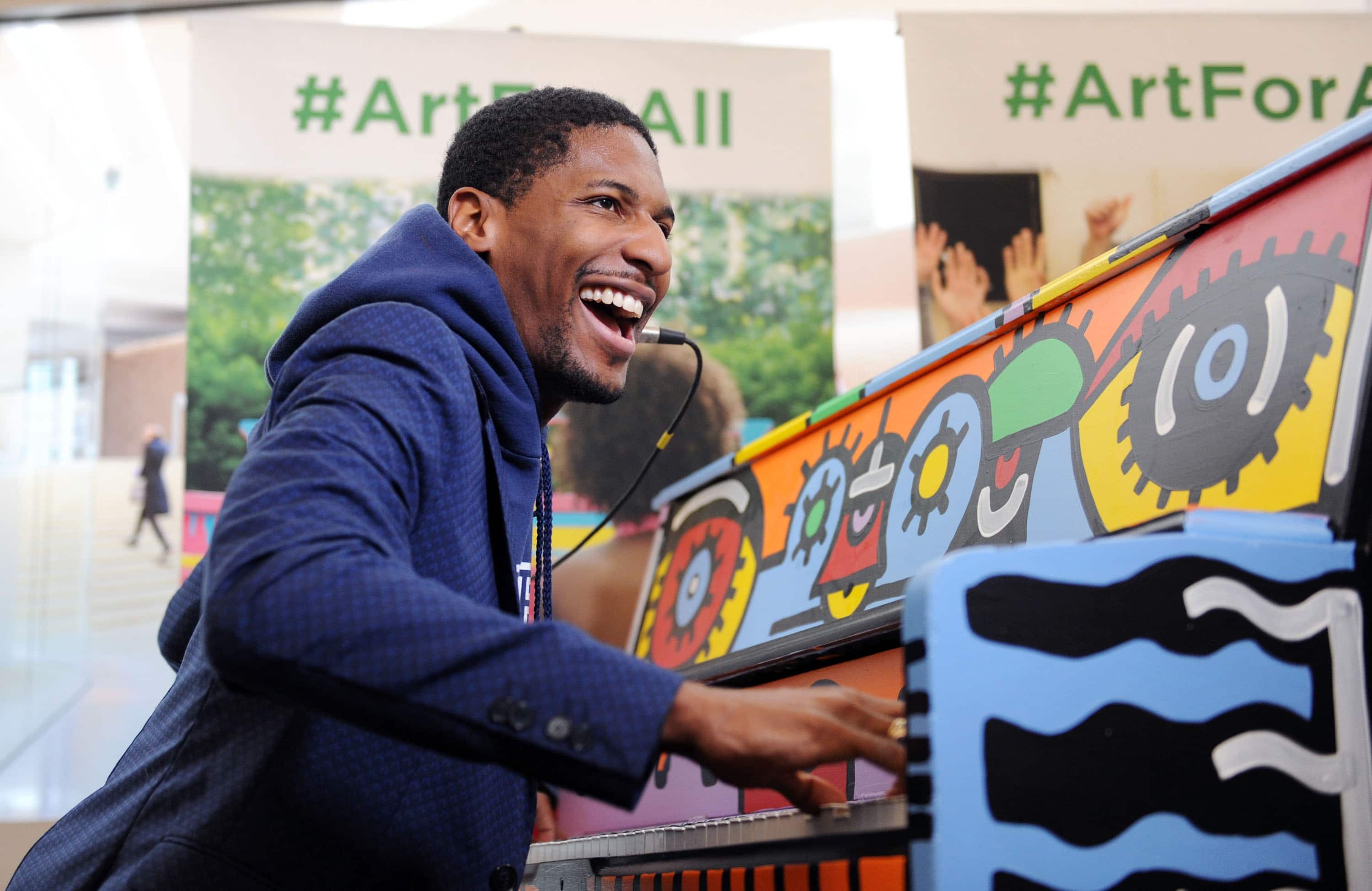Sing for Hope’s Camille Zamora: Art as a Delivery System for Hope

Camille Zamora and Monica Yunus. Photo by Fay Fox.
BY PAKSY PLACKIS-CHENG
Over the course of a decade, Sing for Hope‘s art outreach programs have reached thousands of individuals in under-resourced schools, hospitals, veterans’ centers, and many other community organizations across the five boroughs of New York. To date, Sing for Hope has partnered with over 250 nonprofit organizations, involved over 3,500 artists in community volunteerism, and placed over 400 artist-created Sing for Hope Pianos throughout NYC’s parks and public spaces for everyone to play.
Musicians Camille Zamora and Monica Yunus are the organization’s co-founders and co-executive directors.
Melissa Walker interviewed Monica Yunus for impactmania. Read on for Camille Zamora’s chat with impactmania about singing and social entrepreneurship.
Camille, you are in two of the most challenging fields: opera and education.
I must be insane. [Laughs.] I think it’s fascinating how our paths evolve in life. I certainly never set out thinking that this is where I would be.
I grew up in Texas. I was lucky enough to have good public school music, and of course, New York City is where you want to go if you’re a musician in this country. I was fortunate enough to get into Juilliard and to study with these teachers that I had known of as a kid, these icons of our profession.
Yet, at the same time, there’s this realization that even though we are here in this arts epicenter of our country, if not the world, the majority of New Yorkers don’t have access to these treasures.
Fast-forward a decade: I am lucky enough to work in the profession as an opera singer. At the same time, together with Monica Yunus, my dear friend and fellow soprano, I am the co-founder and the co-executive director of an organization that seeks to level the playing field and increase access to this wonderful arts banquet.
What did you see specifically that spurred this?
To begin with, my parents imbued in me a sense of social justice. They had been in the Peace Corps, and they were both people who were about working to create the world as you want to see.
Arriving at Juilliard, I was immersed in this sort of utopia, in terms of being able to dedicate myself to study this art that I’m so passionate about. And yet there was also this sense that we were a little removed from the actual day-to-day concerns of so many people and definitely from some of the social-justice questions that we face in this country.
Monica and I were students at Juilliard on September 11. Juilliard shares the same city block with a firehouse, and those guys were amongst the first responders on that day. They lost 11 guys.
Two days after the tragedy, there we are, musicians, saying, “My God, what can we do?” Here I am in a practice room honing my F sharp, and meanwhile, it feels like the world is falling down around me. There was this weird moment of paralysis following those initial days; everyone was waiting for people to return. Throughout the city, there were these posters of people’s faces.
Two days after September 11, we were at this firehouse, and they were waiting for their guys to come back. And there was this dawning realization that that may not happen. A group of us sang for these guys. It was an important moment, I think, for all of us.
I still remember when this young tenor opened his mouth. We sang “This Land is Your Land.” We sang Americana songs of the spirit. There was definitely a sense that these big, tough men had not yet allowed themselves to reckon with what had happened, and they just wept.
We may not always feel important as artists. We may not always feel invited into this larger diplomatic dialogue, but the truth is, we do have something vital to offer. After that, Monica and I said, “What can be the resource for artists who have this impulse?”
We didn’t know anything about nonprofit; we didn’t know anything about setting up organizations. But we knew that many artists like us felt a need for this outlet, in addition to the more traditional outlets of concert halls and galleries. At that time, you couldn’t just show up at a school or hospital or veterans’ center to share your art. So we thought: what if we create an organization that makes those inroads? We started organically with a group of friends. Then a year or two later, we met the wonderful Eva Haller, [also part of impactmania’s Women of Impact] who became our first board member and our first board chair.
In 2006, we became an official nonprofit. Today, almost 11 years later, Sing for Hope has become the go-to resource for artists who want to give back. We are super honored to be working with thousands of New Yorkers and bringing the arts to people who wouldn’t have access. … seniors, veterans, people in AIDS hospices, in hospitals, in schools, and very proudly, we are bringing the pianos to the streets. The Sing for Hope Pianos are a tangible symbol of art for all, our mission.
What is something you’ve learned building Sing for Hope?
I would definitely say we have learned that our naiveties have served us well. We always just went for it in kind of a fearless way! [Laughs.]
When you train as an artist, one of the things that you learn to do is to take a deep breath, to connect with yourself in an authentic way, and then share from your heart. That core lesson has served us well because whether it’s bringing people in to be part of this movement or trying to seek funding, we’re able to do it in an authentic way.
… There’s something wonderfully vulnerable about making art. When you grow up doing that, you develop that same ability to be vulnerable in all of your life’s pursuits, and to go out on a limb for things that are important to you.
That’s one thing that has served us well. The lessons that we learned in training as operatic sopranos have actually served us very well as social entrepreneurs: the artistic habits of mind… That is something my dear friend, Damian Woetzel, the chair of our programming committee says. He is actually the president-elect of Juilliard.
Give me some examples of artistic habits of mind.
Teamwork, the ability to be vulnerable, comfort with ambiguity, willingness to take calculated risks. We as artists understand that nuance, ambivalence, and ambiguity are part of life.
The first time we went to City Hall to pitch this idea, we had to sell the city on this wonderful crazy idea called the Sing for Hope Pianos.
Then, comfort with ambiguity…we joke that Sing for Hope has a lucky star in real estate because where do you put 88 pianos and their artists in New York City? In fact, every year of the project, we have managed to find an angel who has come out of nowhere to provide a place. We have been the beneficiaries of generosity from Fosun, which is a China-based company that owns a wonderful building downtown, 28 Liberty. They have kindly loaned us that space for two years. Because without that space, how could we have done the program?
You mentioned that in a way, you were prepped for taking this on. But still, running an organization — developing staff and building an endowment — is such a different beast than performing onstage.
You’re so right.
There must have been a point where you and Monica, or you versus Monica, said, “I’ve had enough. I don’t see how I can carry this to the next level.”
Absolutely, we have that moment on a daily basis! [Laughs.] We are so fortunate in the mentors that we have. When we meet someone who inspires us or someone who has a skill set that we feel that we can benefit from, we chase after them. [Laughs.] We have benefited from the wisdom of a lot of major thinkers in the nonprofit space and in the social-entrepreneur space.
It is a very interesting moment for the arts and culture in our country. We are aware of the fact that certain divisions have become entrenched, and that the classical music audiences of our parents’ generation don’t exist in the same way.
But we also have to look at the fact that there isn’t as much exposure, as much music education. What is the gateway for kids? There are a lot of different answers to that question. But one thing that we often refer to is this idea of “radical welcome.”
Not just, I’m going to say to you, “You can come to my show. I’ll give you a discounted ticket, and I hope you come.” No, what we say is, “We’re going to come to your home and bring you this gift.” By that, I mean we are going to place a hot pink piano in the middle of the Bronx Grand Concourse.
We are going to say, “This is yours forever.” We give this to you, and we will come and activate it with you. It is taking the extra step, beyond tokenism, and saying, “This is about honoring the artist that is you and finding ways that we can collaborate.”
I have dedicated my life to honing Mozart arias, while you may not have ever even sung in a chorus or had even minimal arts experiences in a classroom. But we can create a collaboration if we spend the time, and if we really open our eyes and our ears to each other.
We also feel that when we don’t have the answers, we have the comfort level to ask the questions. An early board member, Luis Moreno, said a wonderful thing early on, which is, “Don’t be afraid to act; just fail quickly.” When it comes to building a team, to hiring, it can be very paralyzing when you think you have to hire the perfect person.
We realize that certain things you attempt are not going to work, and that’s okay. Then I think the important thing is to say, “I’m sorry,” and you move on.
With all that you have learned, what do you feel is needed to create social impact?
Our feeling is that the arts are a delivery system for hope. If you don’t have a baseline feeling of wellness and joy when you think about the future… then it’s next to impossible to learn and it’s next to impossible to heal.
There’s the core belief in the power of the arts to allow you to see a better world. The arts allow you to envision that … and then create it. Why are we living in New York City in these crazy high rents if not because in part, we are inspired by the arts and the creativity of New York City as an entity? And yet, the majority of our kids don’t have regular access to live arts experience.
Artists are a grassroots solution to this inequality. … You have to create the network of support for these artists, and that’s where Sing for Hope comes in.
The artists themselves are enriched through this. Because creativity is an endlessly renewable resource, and you only increase your creativity when sharing it.
You wrote something very interesting: “Music informs identity, to the extent that you carry those who came before you.” So tell me, whom does Camille carry forward?
What a sweet thing to ask. I do think for me, very powerfully, my father. My father was Spanish, and so some of my first memories are of him playing a Spanish classical guitar that he loved. …
He was the one who always said, “Camille, you can sing; you can do this.” He loved my singing; we used to do little songs together. I sing in different styles in a bunch of different languages, but I really have always loved the classics of the Spanish repertoire, and I do think part of that is from my heritage. I feel super lucky that much of my work with orchestras now centers on performing the Spanish classics of Granados, Piazzolla, de Falla, Gardel, Tarragó, etc. It’s such delicious music.
There is this sense of deep connection when we sing, the music that sort of came before us. We can discover new parts of ourselves…
What have you figured out about yourself through singing?
Gosh, I think that singing has kept me healthy. I’m a sensitive person, I feel things intensely, and that’s a blessing and a curse. Singing allows me to get my energy flowing in a positive way. It’s been a real call to health and to balance for someone who maybe wouldn’t have been so healthy and balanced otherwise.
We always ask interviewees who has left an imprint on their professional DNA. With you, it has clearly been your father?
Yes, definitely.
Is there something he has done that impacted how you run Sing for Hope?
My father was the first person in his family to go to college. He ended up having this really amazing academic career; he was a legal scholar and the first Hispanic dean of a college in Texas; he was the dean of the law school at University of Houston.
… He founded something called the Center for U.S. and Mexican Law. So he was somebody who used his academic passions in a way that was not exactly intuitive. It wasn’t the standard path, but it reflected his desire to build bridges. Clearly, he was someone who wanted to unite people, and include people in a conversation that perhaps hadn’t been established.
Again, that idea of radical welcome — an intentional inclusion of disenfranchised people.
When it comes down to dedicating my life to the study of classical voice — which is a complete joy and a luxury — ultimately, I do that most comfortably when I know that I’m also working to include people who never would have been included …
It comes down to what sort of world you want to live in, and my father was wonderful with that.
Another person has left an indelible influence on me… I’ve been lucky enough to work with Yo-Yo Ma…
I was in a recording studio with him recording a beautiful piece and I remember looking around, and everyone in the studio that day was so happy. It was because Yo-Yo had engaged in such an authentic way with every individual — from myself to our pianist to the guy whose job it was to open the door and turn on the lights …
Yo-yo really honored and saw each person. I think that sense of connection, of engaging in such an authentic way, is part of what makes his music so magical.
That day in the recording studio with Yo-Yo, that was a revelation, just taking that extra second to connect with the people that cross your path…

Jon Batiste performs at the 6th Annual Sing for Hope Pianos Kickoff Event At 28 Liberty Plaza on June 5, 2017 in New York City. Photo by Craig Barritt/Getty Images. Courtesy of Sing For Hope.
When the president walks into the room, a fanfare is played. What would they play if Camille walked into the room?
This beautiful cacophony of pianos [played] together at the recent 2017 Sing for Hope Pianos launch. In that moment, they were all playing Bach, Prelude in C, and just ever so slightly out of sync, because how do you get everybody together?
The blissful sound of all of these people just together in this moment because their hearts have called them to be there … and knowing that these pianos are about to head out on their journey, out into the streets, and later to the schools, that is my moment.

